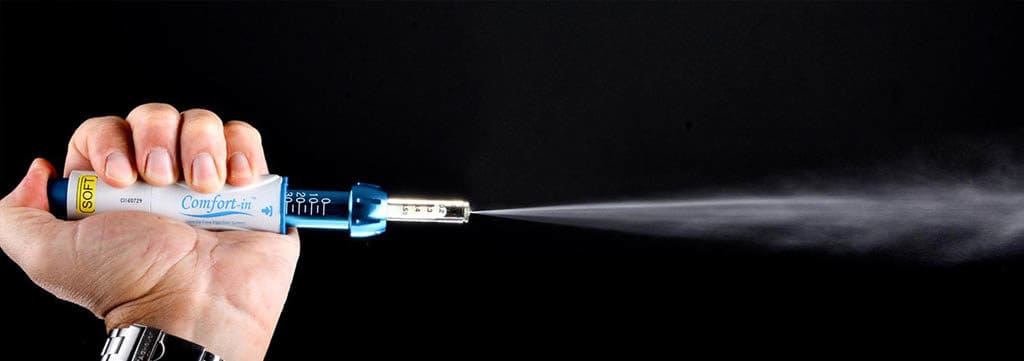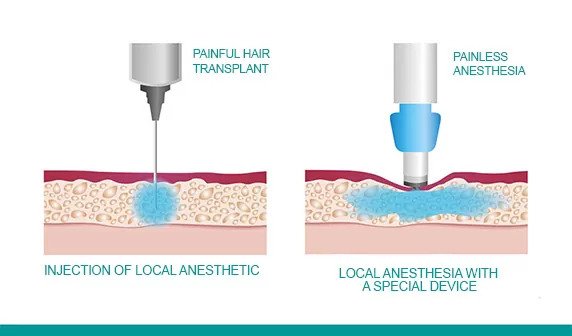Hair Transplant in Comfort: A Blissful Technique

Needle-free Hair Transplant (Comfort-in)
As in all surgical operations, anesthesia in hair transplants is one of the most important factors in ensuring the patient experiences a comfortable operation throughout. Anesthesia is applied to both the donor area (the nape of the neck) and the target area where the hair will be transplanted to. Due to the size of the area to be operated on, anesthesia is an inevitable part of the procedure, however a local anesthesia is used rather than a general.

Is Hair Transplant Painful?
Many people that hair transplant is painful? Yes, it was a few decades earlier. Now with the advent of the new technique like usage of anesthesia (with or without needle insertion) helped a lot to get of pain during the hair transplant and prevents itching after hair transplant.
Hair Transplant in Comfort
Many people are aware that special drugs are applied to the site to avoid pain during the operation however the methods used to alleviate operative pain may themselves produce distress in many people. In other words, even though they know they will not feel a thing after the anesthesia is delivered, people are still afraid of anesthesia injections. This is a commonly encountered situation in medicine. About 20-23% of the adult population have needle phobia to such an extent that it causes them to avoid needed medical care.
The Need for Anesthesia in Hair Transplant without Pain
Administration of anesthetic agents prior to the two fundamental processes of a FUE hair transplant procedure is unavoidable. The active ingredient in the anesthetic agent delivered into the skin, only numbs the surrounding area where the anesthetic has been given, enabling the micro surgical procedure to be carried out. The choice of anesthetic technique to be applied will obviously have an impact on the level of comfort experience and the level of comfort experienced throughout the operation and are related to the anesthetic technique that is being conducted.
Anesthesia facts about hair transplant
Here are some facts about hair transplant:
- Hair restoration surgery isn’t painless, but pain control is much more effective today than even in the recent past. Medical research has improved understanding of nociception – how a sensation of pain is received, transmitted and interpreted by nerves from the site of injury to the spinal cord and the brain.
- There is better understanding of the relationship between effective anesthesia and limitation of bleeding during surgery. An inadequately anesthetized, anxious patient may have increases in heart rate and blood pressure that increase risk for bleeding; thus, anesthesia level and physical signs such as heart rate and blood pressure are carefully monitored during surgery.
- Discomfort may be alleviated by administration of anti-anxiety medication. Patients who believe that they cannot endure discomfort of injections for local anesthesia may be pretreated with an anesthetic applied to the skin that temporarily reduces the patient’s ability to sense pain at a local site.
Anesthesia Safety Usage
Proper selection of an anesthetic includes safety considerations. In preoperative screening, the patient is asked if they ever had an adverse reaction or side effect from an anesthetic; adverse reactions and side effects include allergic reactions, nausea, vomiting, itching, breathlessness, increased or decreased heart rate, or severe systemic effects that required emergency medical treatment or hospitalization.
The patient should ask the physician to discuss what anesthetics are to be used, with explanation of the rationale and potential side effects.
Procedure involved in application of Anesthesia
The methods of application of anesthesia are:
- General anesthesia: When it comes to anesthetics used in a hair transplant procedure, general anesthesia usually does not take place among them. While general anesthesia puts the patient into a deep sleep it also carries a higher risk of serious complications.
- Regional anesthesia: Regional anesthesia can be expressed as the process of making a specific part of the body numb to relieve pain. Just like general anesthesia, regional anesthesia is also not used in a hair transplant surgery.
- Local anesthesia: Local anesthetics is the most widely used type of anesthesia in hair transplant procedures. Local anesthesia can be administered by needle-free jet injection (diffusion with high pressure) and by the traditional injection technique.
- Sedation: Among other applications, this method stands out to be the most comfortable practice. It can be applied both through inhalation as well as vascular access placed from the arm.
The element that increases the feeling of comfort, is the ability to adjust the dose of sedation according to the patients’ needs and through continuous monitoring, the ability to reduce its effect whenever needed.
Since babies can also be administered sedation, it can be considered as a highly safe method.
But here comes the good part? Anesthesia can now be inserted in the body without the use of needles/pins. Comfort-in is one of the most advanced needle-free injection systems which is spring operated. This little device uses liquid medicine itself instead of a needle. In other words, it applies high-pressure liquid under the epidermis. A receiver patient only feels this pressure of the liquid against the skin. This device has a 0.15 mm orifice and it has a very high-speed jet delivery system.
At RepHair clinic, the anesthesia for hair transplants is now applied without the use of needles, instead a pen-like device (Comfort-in). The Comfort-in device works by spraying the anesthesia deep into the target area where it is then absorbed beneath the layers of skin. The Comfort-in device was created to help people who have a phobia of needles to enable them to have a comfortable experience both physically and psychologically.
Miscellaneous Factors which make Hair Transplant Procedure Pain-Free
- The use of micromotor that rotates at a low speed during the extraction process is used.
- A Micromotor featuring small cylindrical needles that are made of high-quality surgical steel grade is used.
- Renewal of the cylindrical needles that are used during the extraction process before the punch becomes blunt due to excessive usage.
- Usage of special sapphire blades instead of steel blades during the process of creating incisions within the recipient site.
- Having the wound-dressings, which will be done shortly after the operation as well as the following day, carried out by health-care professionals, are other factors that can affect the overall comfort of the operation.

